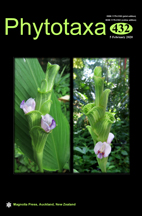Abstract
The name Chenopodium hircinum (Chenopodiaceae) applicable to a South American tetraploid species is lectotypified on a specimen deposited at LE (barcode LE00011694, right-hand specimen) that is associated with H.A. Schrader and his herbarium purchased for LE in 1841. A brief overview of relationships of the pseudocereal crop species C. quinoa with
C. hircinum (considered to be a wild crop relative and/or progenitor) is also provided. Since the lectotype of C. hircinum in LE lacks mature fruits/seeds, which are important for morphology-based diagnostics of taxa of Chenopodium (and also of infraspecific taxa described within C. hircinum), designation of an epitype with well-developed fruits/seeds is desirable according to Art. 9.9 of the ICN. However, we argue that an epitype should be proposed later, after achieving a better understanding of the variability of C. hircinum and proper typification of its infraspecific taxa, because hasty epitypifications could be nomenclaturally confusing and disrupting. In our opinion, an epitype specimen for that taxon name should represent a plant corresponding to the lectotype and well characterized molecularly, genetically and morphologically.

